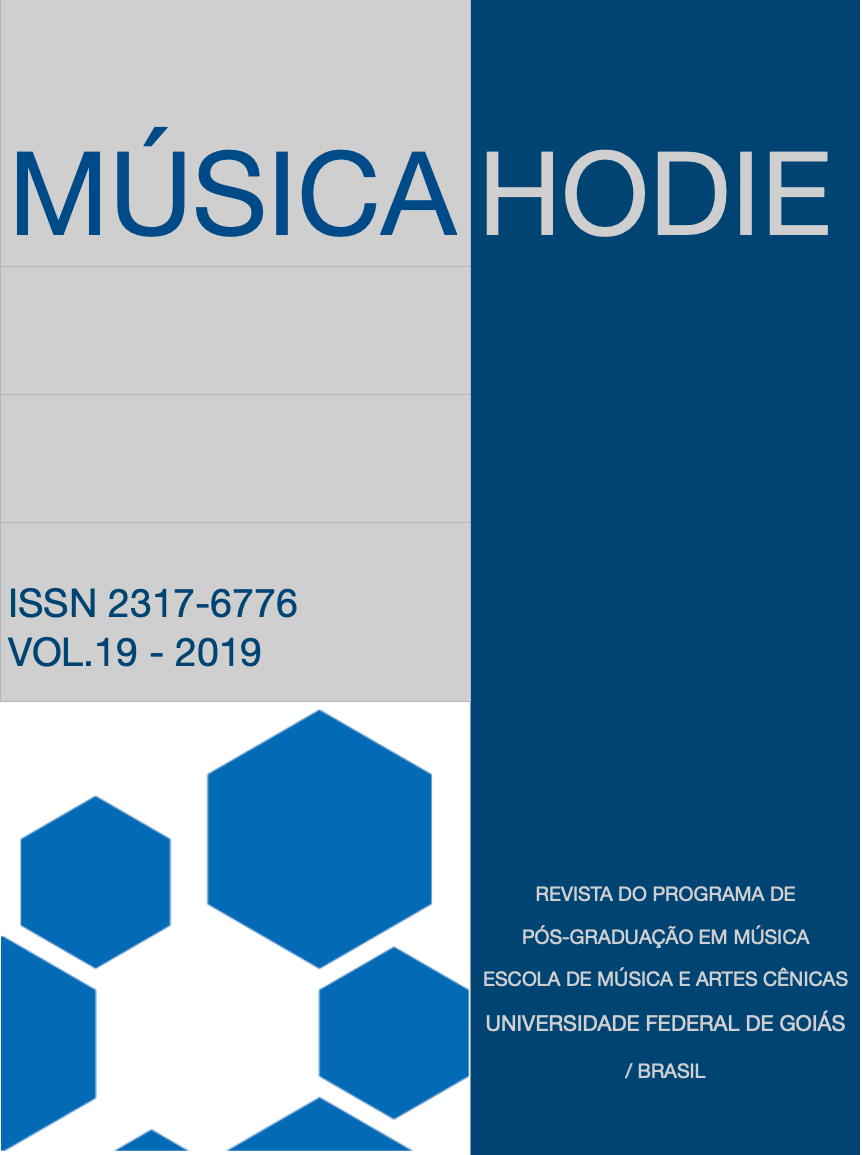Música contemporánea y estrategias de aprendizaje de una nueva pieza musical en la clase de piano
DOI:
https://doi.org/10.5216/mh.v19.52532Palabras clave:
Aprendizagem de curto prazo, estratégias dinâmicas de aprendizagem, performance musical, música contemporânea, aula de piano.Resumen
El presente trabajo de investigación, se centra en el estudio del proceso de aprendizaje a corto plazo de una nueva pieza de música contemporánea en una clase de piano funcional en la Facultad de Artes de la Universidad de Chile. El estudio sigue un enfoque microgenético (SIEGLER, CROWLEY, 1991). Los participantes (n=10) leen 4 veces la pieza seleccionada y tienen la posibilidad de practicar dos minutos entre cada interpretación. Se analizan los datos de la performance, así como la implicación de la maestra y sus estudiantes en la generación de estrategias dinámicas de aprendizaje. Los resultados sugieren la existencia de proto-perfiles de aprendizaje.
Descargas
Citas
ALARCÓN, M. E. Pequeña antología del compositor chileno para piano. Santiago: Instituto Interamericano de Educación Musical, Facultad de Artes, Universidad de Chile, 1993. 55p.
ALTENMÜLLER, E. et al. The impact of music education on brain networks: evidence from EEG studies. International Journal for Music Education, v. 35, p. 47-53, 2000. https://doi.org/10.1177/025576140003500115
AMBERT, A.-M. et al. Understanding and evaluating qualitative research. Journal of Marriage and the Family, v. 57, n. 4, p. 879-893, 1995.
ANDERSON, J.R. Learning and memory. New York: J. Wiley and Sons, 1995. 448p
AUSUBEL, D. P. Learning by discovery. Educational Leadership, v. 20, n. 2, p. 113-117, 1962.
BOUFFARD, L. et al. La gestion des buts personnels, un apprentissage significatif pour des étudiants universitaires. Revue des Sciences de l’Education, v. 27, p. 503-522, 2001.
BRUNER, J. The act of discovery. Harvard Educational Review, v. 31, p. 21-32, 1961.
DEWEY, J. How we think. Boston: Heath, 1910. 250p.
_ _ _ _ _ _. Method in science teaching. Science Education, v. 1, n.1, p. 3-9, 1916.
DRAI-ZERBIB, V.; BACCINO, T. L’expertise dans la lecture musicale: Intégration intermodale. L’Année psychologique, v. 105, p. 387-422, 2005.
DRAKE, C.; PALMER, C. Skill acquisition in music performance: relations between planning and temporal control. Cognition, v. 72, n. 1, p. 1-33, 2000.
ERCIKAN, K.; ROTH, W. M. What good is polarising research into qualitative and quantitative? Educational Researcher, v. 35, n. 5, p. 14-23, 2006. https://doi.org/10.3102/0013189X035005014
ERICSSON, K.; SIMON, H. Verbal reports as data. Psychological Review, v. 87, n. 3, p. 215-251, 1980. http://dx.doi.org/10.1037/0033-295X.87.3.215
CARVER, C. S.; SCHEIER, M. F. On the self-regulation of behavior. Cambridge: Cambridge University Press, 1998. 460p.
CHAFFIN, R. et al. “Seeing the big picture”: Piano practice as expert problem solving. Music Perception, v. 20, n. 4, p. 461-485, 2003. http://www.jstor.org/stable/10.1525/mp.2003.20.4.465
CHASE, W. G. (1983). Spatial representation in taxi drivers. In: D. R. ROGERS, J. H. SLOBODA (Eds.), Acquisition of symbolic skills. New York: Plenum, 1983. p. 391-405.
COFFMAN, D.D. Effects of mental practice, physical practice, and knowledge of results in piano performance. Journal of Research in Music Education, v. 38, n. 3, p. 187-196, 1990.
FLAVELL, J. H. Development of children's knowledge about the mental world. International Journal of Behavioral Development, v. 24, n. 1, p. 15-23, 2000. https://doi.org/10.1080/016502500383421
FIREMAN, M., C. A escolha de repertório na aula de violão como uma proposta cognitiva. Em Pauta, v. 18, n. 30, p. 93-129, 2007. http://www.seer.ufrgs.br/index.php/EmPauta/article/view/7468/4654
GLASER, R.; CHI, M. Overview. In: M. CHI, R. GLASER, M. FARR (Eds.), The nature of expertise. Hillsdale, NJ: Erlbaum, 1998. p. 15-28.
GRAESSER, A.C.; ROBERTSON, S.P.; ANDERSON, P.A. Incorporating Inferences in Narrative Representations: A study of How and Why. Cognitive Psychology, v. 13, n. 1, p. 343-370, 1981.
GOBET, F.; SIMON, H. A. (1996). The roles of recognition processes and look-ahead search in time-constrained expert problem solving: Evidence from grand-master-level chess. Psychological Science, v. 7, n. 1, p. 52-55, 1996. https://doi.org/10.1111/j.1467-9280.1996.tb00666.x
GRANGEAT, M. Les régulations métacognitives dans l'activité enseignante : rôle et modes de développement. Revue des Sciences de l’Éducation, v. 36, n. 1, p. 125-150, 2010.
https://doi.org/10.7202/043994ar
GRUHN, W. Are different types of mental representation reflected by brain activation patterns. In: S. D. LIPSCOMB, R. et al. (Eds.), Proceedings of the 8th International Conference on Music perception and Cognition (p. 124-127). Evanston, IL, 2004
_ _ _ _ _ _. RAUSCHER, F. H. (2008). The neurobiology of learning: New approaches to music pedagogy. In W. GRUHN, F. H. RAUSCHER (Eds.). Neurosciences in music pedagogy. New York: Oxford University Press, 2008. p. 267-282.
JUUTI, S.; LITTLETON, K. (2012). Tracing the Transition from Study to a Contemporary Creative Working Life: The Trajectories of Professional Musicians. Vocations and Learning, v. 5, n. 1, p. 5-21, 2012. https://doi.org/10.1007/s12186-011-9062-9
KERMARREC, G. Stratégies d’apprentissage et autorégulation. Revue de question dans le domaine des habiletés sportives. Science et Motricité, v. 53, n. 3, p. 9-38, 2004. http://dx.doi.org/10.3917/sm.053.0009
KINTSCH, W.; VAN DIJK, T.A. Towards a model of text comprehension and production. Psychological Review, v. 85, n. 5, p. 363-394, 1978. http://dx.doi.org/10.1037/0033-295X.85.5.363
LE BAS, A. Peut-on modéliser les activités physiques en éducation physique et sportive en termes de problématisation ? L’exemple de la course de haies. Recherches en Education, v. 11, 164-177, 2001. http://www.recherches-en-education.net/IMG/pdf/REE-no11.pdf
LEHMANN, A. C.; ERICSSON, K. A. Performance without preparation: Structure and acquisition of expert sight-reading and accompanying performance. Psychomusicology, v. 15, n. 1-2, p. 1-29, 1996. http://dx.doi.org/10.1037/h0094082
MARCHAND, C. Pour une didactique de l'art musical. Paris: L'Harmattan, 2009. 312p.
MARCZYK, G.; DeMATTEO, D.; FESTINGER, D. Essentials of Research Designs and Methodology. New Jersey: John Wiley & Sons, 2005. 306p.
MARTENIUCK, R. G. Information processes in movement learning: capacity and structural interference effects. Journal of Motor Behavior, v. 18, n.1, p. 55-75, 1986. https://doi.org/10.1080/00222895.1986.10735370
MCPHERSON, G. E.; MCCORMICK, J. Self-efficacy and music performance. Psychology of Music, v. 34, n. 3, p. 321-336, 2006. http://dx.doi.org/ 10.1177/0305735606064841
NIELSEN, S. G. Learning strategies in instrumental music practice. British Journal of Music Education, v. 16, n. 3, p. 275-291, 1999. http://dx.doi.org/10.1017/S0265051799000364
PHELPS, R.; FERRARA, L.; GOOLSBY, T. W. A Guide to Research in Music Education. 4. ed. New Jersey: The Scarecrow Press, 1993, 367p.
RICHARD, J. F. Les activités mentales. Paris: Armand Colin. 1998. 430p.
ROSENBAUM, D. A. (1987). Hierarchical organization of motor programs. In: S. Wise (Ed.), Neural and behavioral approaches to higher brain functions. New York: Wiley, 1987. p. 45-66.
SCHÖN, D.; AKIVA-KABIRI, L.; VECCHI, T. Psicologia della musica. Roma: Carocci, 2008. 126p.
SEBILLOTTE, S. Décrire des tâches selon les objectifs des opérateurs. De l’interview à la formalisation. Le travail Humain, v. 54, n. 3, p. 193-223, 1991. https://hal.inria.fr/inria-00070042/document
SWELLER, J. Cognitive load during problem solving: Effects on learning. Cognitive Science. 12, n. 2, p. 257-285, 1998. http://dx.doi.org/10.1207/s15516709cog1202_4
WILLIAMON, A.; VALENTINE, E.; VALENTINE, J. Shifting the focus of attention between levels of musical structure. European Journal of Cognitive Psychology, v. 14, n. 4, p. 493-520, 2002. https://doi.org/10.1080/09541440143000221
WITTROCK, M. C. Students’ thought processes. In: M. C. WITTROCK (Ed.). Handbook of research on teaching (3rd ed.). New York: Macmillan. 1986. p. 297-314.
WOLF, T. A cognitive model of musical sight-reading. Journal of Psycholinguistic Research, v. 5, n. 2, p. 143–171, 1976.















